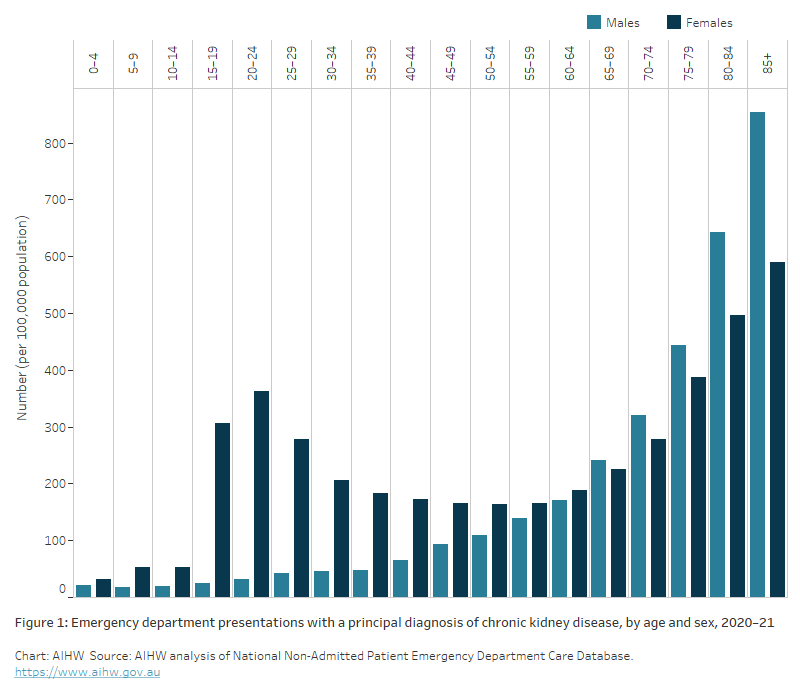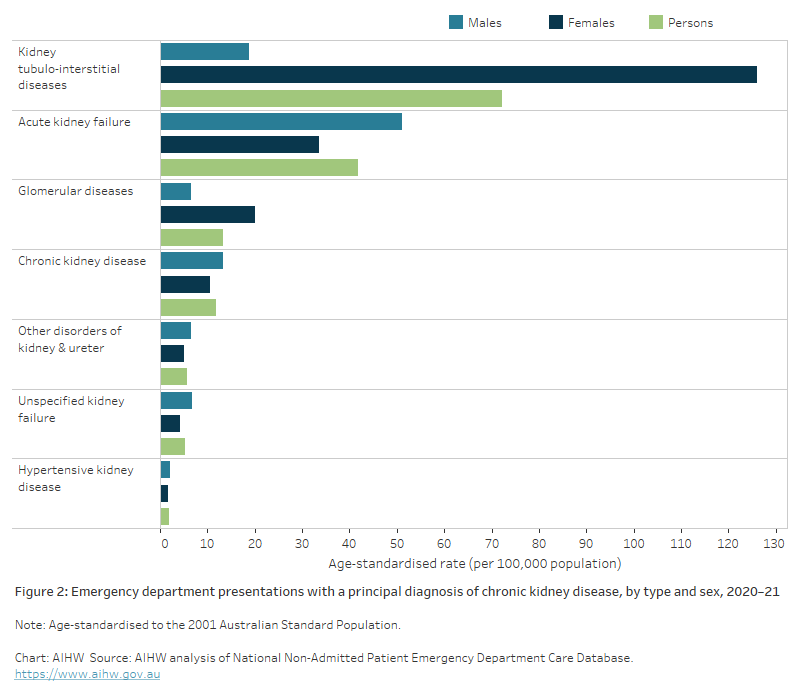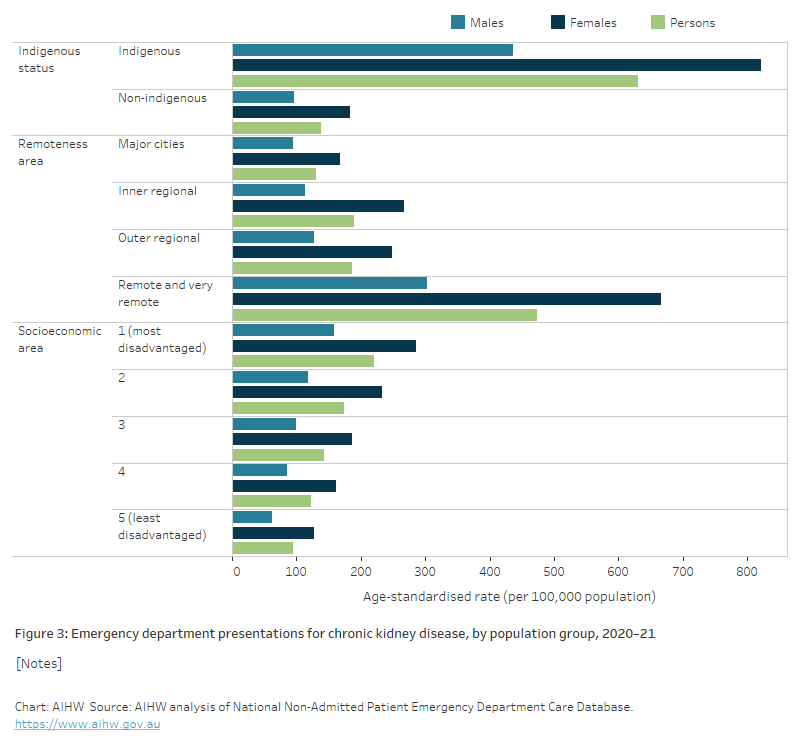Emergency department presentations
Emergency departments (EDs) are an essential component of Australia’s health care system. Many of Australia’s public hospitals have purpose-built EDs, staffed 24 hours a day, providing care for patients with chronic kidney disease (CKD) who require urgent medical, surgical or other attention.
In 2020–21, there were around 42,300 emergency department presentations with a principal diagnosis of chronic kidney disease.
Variation by age and sex
In 2020–21:
- around 14,900 males and 27,400 females presented to EDs with a principal diagnosis of CKD
- the rate of presentation for females was 1.9 times as high as the male rate
- in males, the rate of presentation increased with age, and ranged between 18 and 850 presentations per 100,000 population. Beyond age 65, rates of presentation were higher in men than women (Figure 1)
- in females, there was an initial peak in presentations between the ages of 20 and 24 (363 presentations per 100,000 population). This peak mainly comprised ED presentations with a principal diagnosis of tubulo-interstitial nephritis. Following this peak, the rate of ED presentations increased with age. The rate of presentation for females ranged between 32 and 590 per 100,000 population (Figure 1).
Figure 1: Emergency department presentations with a principal diagnosis of chronic kidney disease, by age and sex, 2020–21
The bar chart shows the number of emergency department (ED) presentations with a principal diagnosis of CKD, by age group and sex in 2020-21. Among males, presentations increased with age and the highest rate of male ED presentation was in the 85+ age group (853 per 100,000 population). Among females, there were two peaks in the number of ED presentations, in the 20-24 age group (364 per 100,000 population) and the 85+ age group (590 per 100,000 population).

Types of chronic kidney disease
In 2020–21, there were around:
- 13,100 ED presentations with a principal diagnosis of acute kidney failure, accounting for 31% of all CKD-related ED presentations. This was the most common principal diagnosis among men (58 presentations per 100,000 population) (Figure 2).
- 18,500 presentations with a principal diagnosis of kidney tubulo‑interstitial disease. After adjusting for age, women were approximately 6.7 times as likely as men to present to ED with a diagnosis of tubulo‑interstitial nephritis and this was the principal diagnosis in around 58% of CKD-related female ED presentations. Tubulo‑interstitial nephritis includes acute and chronic forms as well as pyelonephritis.
Figure 2: Emergency department presentations with a principal diagnosis of chronic kidney disease, by type and sex, 2020–21
The bar chart shows the number of emergency department (ED) presentations with a principal diagnosis of CKD, by CKD type and sex in 2020-21. Among females, kidney-tubulo interstitial diseases were the most common principal diagnosis (126 presentations per 100,000 population). Among males, acute kidney failure was the most common principal diagnosis (51 presentations per 100,000 population).

Variation across population groups
Aboriginal and Torres Strait Islander people
- In 2020–21, there were around 4,200 ED presentations with CKD as the principal diagnosis among Indigenous people. The rate of ED presentations in Aboriginal and Torres Strait Islander males and females was 292 and 677 per 100,000 population, respectively.
- After adjusting for age, Indigenous Australians were 4.6 times as likely as their non‑Indigenous counterparts to present to an ED with a CKD-related diagnosis (Figure 3).
Remoteness and socioeconomic area
- The rate of CKD-related ED presentations increased with remoteness. People in Remote and very remote areas were 3.6 times as likely to present to ED with a CKD‑related diagnosis as people living in Major cities (Figure 3).
- Presentations to ED increased with increasing socioeconomic disadvantage. Individuals in the lowest socioeconomic areas presented with CKD-related diagnoses at 2.3 times the rate of those in the highest socioeconomic areas.
- Across all levels of remoteness and socioeconomic disadvantage, females had a consistently higher rate of ED presentation than males.
Figure 3: Emergency department presentations for chronic kidney disease, by population group, 2020–21
The bar chart shows the number of emergency department (ED) presentations Indigenous status, remoteness area and socioeconomic area. Indigenous people presented to the ED at 4.6 times the rate of their non-Indigenous counterparts. Persons in Remote and very remote areas were 3.6 times as likely to present to the ED with a principal diagnosis of CKD. The rate of CKD-related ED presentations increased with increasing socioeconomic disadvantage. The most disadvantaged socioeconomic areas had a presentation rate 2.3 times that of the most advantaged socioeconomic areas.

Triage category
Triage category is used to indicate the level of urgency of a patient’s need for care. In 2020–21, among all CKD-related ED presentations:
- 247 (0.6%) were triaged as ‘resuscitation’, indicating a need for immediate care
- 6,200 (14.7%) were triaged as ‘emergency’, requiring care within 10 minutes
- 24,800 (58.7%) were triaged as ‘urgent’, requiring care within 30 minutes
- 10,400 (24.6%) were triaged as ‘semi-urgent’, requiring care within 60 minutes
- 600 (1.4%) were triaged as ‘non-urgent’, requiring care within 120 minutes.
End status
In 2020–21:
- around 73% of presentations to ED with a principal diagnosis of CKD were later admitted to the hospital to which they presented
- around 23% of presentations left the ED without being admitted or referred to another hospital
- 3.3% of presentations to the ED with a principal diagnosis of CKD were referred to another hospital for admission.
Further information
For more information on acute kidney injury, see: Acute kidney injury in Australia: a first national snapshot.


